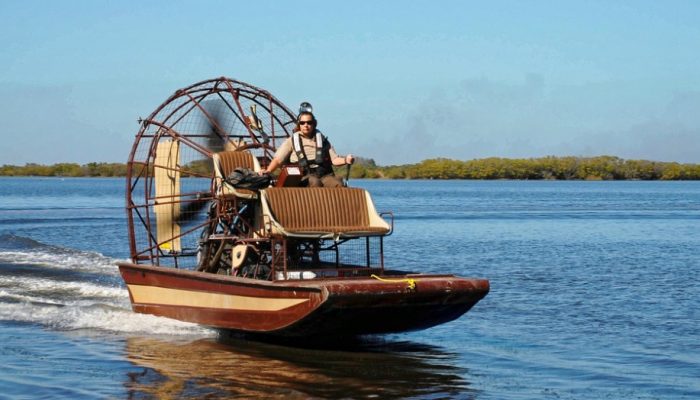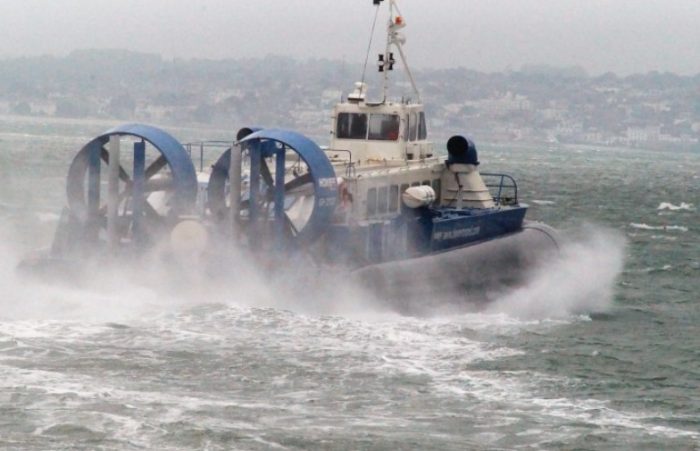The best type of boats to use in a swamp are airboats, also known as fan boats or swamp boats. These boats have flat bottoms and large propellers powered by jet engines or automobile motors. They can navigate effectively over obstacles that would stop a regular boat.
Key Takeaways
- Airboats can be used in marshy, shallow, or icy waters because they are somewhat amphibious
- Airboats are mainly used for rescues because they are safer, larger, and more durable than other rescue boats, military, and border patrol boats
- Airboats are well-designed and have a flat bottom and don’t have any operating parts below the waterline
- The safety of an airboat greatly depends on the training and skill of its operator and the use of safety features
History of airboats

Airboats are well-designed to cater to boating needs in swamps, marshy water, and areas with obstacles. They have a flat bottom and don’t have any operating parts below the waterline, making navigation through shallow water, swamps, marshes, frozen lakes, and ice manageable. The design of these boats also makes them ideally suited for ice and flood rescue operations.
Alexander Graham Bell invented the first-ever airboat in 1905 in Nova Scotia, Canada, but they were first used in 1915 by the British Army in the world war1 Mesopotamia campaign. Civilians did not use airboats until the 1930s.
Prototypes
The first airboats were generally prototypes or testing vehicles to see how practical the invention was. Let’s look at the three known prototypes and how they performed.
- The ugly duckling by Dr. Alexander Graham Bell
This model was built in Nova Scotia, Canada, in 1905. It was a catamaran-type boat propelled by an aircraft propeller hooked to a water-cooled aircraft engine weighing 2500 pounds. This raft-like vessel only managed a top speed of 3.5 knots, equivalent to 4 miles per hour.
- Hydrofoil by Alberto Santos-Dumont
In 1907, the Brazilian aviation pioneer Alberto also built a catamaran similar to the one by Dr. Graham to test an aircraft engine. As the vessel gained speed, it lifted the boat’s hull out of the water to reduce drag and increase speed.
- La Rapier II by the Tellier brothers
French aviation pioneers also attempted an airboat with the La Rapier II, a significant step toward modern airboats. This prototype was a 26ft long mahogany speedboat powered by an aircraft propeller paired with a 20hp four-cylinder Panhard-Levassor engine. It was steered by a conventional rudder hooked up to a ship’s wheel. La Lapierre could achieve speeds of 14 knots or 16 mph with two people on board and 13 knots or 16 mph with 3-4 people on board.
Early airboats
After the testing, vehicles came to the early airboats that saw their first actual use in 1915. They were referred to as Lambert “hydro-Glisseurs,” and the British army used them in the Mesopotamian campaign of the first world war. These airboats were small, flat-bottomed hydroplanes with metal-clad wooden hulls propelled by an aircraft fan. The vessels could reach a speed of 48 knots or 55 miles per hour. After the world war, the boats were used as ferries on the Huangpu River, Upper Yangtze river, and other regions.
In 1920, Farman aircraft, the company that built engines for the military airboats in WW1, started producing civilian airboats and marketed them as water taxis or patrol boats.
Over the years, the design of airboats has evolved through trial and error, and most airboat manufacturers are small family-run businesses that assemble boats made on order. Most airboats are made in Russia, the United States, Finland, Italy, Japan, and Australia.
Commercially made airboats have hulls made of fiberglass or aluminum, depending on the vessel’s terrain. Airboats used in swamps and marshes have light fiberglass hulls, while those intended for icy conditions will have sturdy polymer-coated aluminum hulls.
Safety of airboats
The safety of an airboat greatly depends on the training and skill of its operator and the use of safety features such as personal floatation devices and seat belts. These vessels should only be operated by qualified and trained operators with knowledge of operational safety to prevent accidents.
Airboats are prone to capsizing because they are unstable and top-heavy with shallow drafts. Driving them on the open sea in stormy and rough weather is extremely dangerous.
To guarantee the safety of airboats, there are regulations governing their manufacture and use. For example, Florida state law requires airboats to have an automotive-style factory muffler that muffles the sound of the engine exhaust, underwater exhaust, and an international orange flag to increase visibility and reduce the odds of a collision. Airboat operators are also required to be at least 14 or older.
What are the different uses of airboats?

Airboats can be used for various rescue operations, military use, and ecotourism. These boats are versatile because they can cruise on marshes and are significant. Let’s look at their uses and how they are adapted for these tasks.
Military use
Since time immemorial, airboats have been used by the U.S. Coast Guard and various militaries and border patrols worldwide.
Rescue
Airboats are now necessary for shallow water, flood, and ice rescue operations making them popular in public safety uses.
After Hurricane Katrina in 2005 in New Orleans, airboats were used to rescue flood victims in less than 36 hours. These vessels come in handy for rescues where regular vessels wouldn’t maneuver, such as in wreckage. They are safer, more significant, and faster than other boats used in ice rescues.
Tourism
Airboats are a popular ecotourism activity, and they are popular in the Florida Everglades and Louisiana bayou. These locations offer airboat tours that last between 60 and 90 minutes and carry passengers at speeds of up to 60mph. Tour companies in these regions have experienced captains that can point out wildlife, flora, or alligators to tourists from a safe distance.
Valuable tips for boating in shallow water, swamps, and marshes
- Always use a boat that is specifically designed for shallow water or swamps. Airboats and flatboats are your best bet because obstacles won’t hinder them.
- Slow down whenever you’re unsure of the depth, and you fear that you might run aground
- Wear the proper attire depending on the weather, in a hot climate; choose light and layered clothing and in cold weather, wear a poncho or rain jacket to keep you from getting wet and cold
- Remember to have insect repellant and sun protection with you.
- Travel in groups; having companions makes the journey more enjoyable and safer because you can navigate risks.
- Keep a safe distance from wild animals: seeing wildlife is a fun part of exploring swamps, but you should do it from a distance. Please do not interfere with wild animals as it is illegal in most states
- Have a solid plan to guide you before you embark on the trip: it is common to encounter travel tour injuries when you don’t have a solid travel plan. Hire a guide to help you map your path and plan for any unfortunate situations. Have emergency services contacts ready in case of anything.
Frequently Asked Questions
Are airboats safe to use in the open oceans?
No airboats are not recommended for use on the ocean; they are best for swamps and marshes
What is the difference between airboats and other flatboats?
The main difference between airboats and other flatboats is that they don’t have any mechanical parts below the waterline. Flatboats are suitable for shallow water, but in marshy water, swamps, and solid ice, their mechanical parts may not move as they are, thus causing the vessel to stall.
What is the gas mileage on airboats?
Airboats have an average gas mileage of two miles per gallon because they consume a lot of fuel due to the engine and energy required to propel the fan.
Final word
Cruising on a swamp may be necessary if it’s a rescue operation or adventure such as the everglades in Florida. The best type of boat to use is the airboat designed for marshy water and swamps. Since these boats don’t have moving parts underneath, they rarely get stranded on the water.
References:
- https://www.quora.com/What-are-the-best-boats-to-use-in-a-swamp
- https://charlesbushphoto.com/blog/2020/2/11/boats-for-photographing-in-the-swamp
- https://www.discoverboating.com/resources/tips-for-boating-in-shallow-water

Rockey is a kayaking enthusiast who has been kayaking with a local group for the last five years. He loves using kayaks while out on outings on the water or camping when the friends want to have a BBQ party somewhere on the bank of a local lake. More About James R Rockey at About Page Here: Authors
Based on his experiences with the different types of kayaks, he is sharing his opinion about kayaking tricks and required gears so that a beginner can get started right away.
Find his team on Twitter here. Happy reading!
